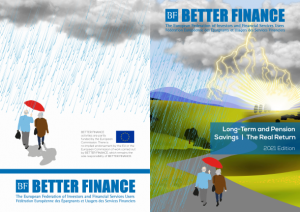 For the ninth year in a row, BETTER FINANCE embarked on the herculean task of gathering all the data on long-term and pension savings in 17 EU Member States and published its annual report on the real net returns of long-term and retirement savings. Unfortunately, the “Real Return of Long-Term and Pension Savings” Report remains the most complete research looking at the performance and actual costs of long-term and pension savings products in the EU.
For the ninth year in a row, BETTER FINANCE embarked on the herculean task of gathering all the data on long-term and pension savings in 17 EU Member States and published its annual report on the real net returns of long-term and retirement savings. Unfortunately, the “Real Return of Long-Term and Pension Savings” Report remains the most complete research looking at the performance and actual costs of long-term and pension savings products in the EU.
Although years of bullish markets improved the long-term returns of most products analysed, too many barely cover inflation and only a handful come close to the performance of a simple, broad EU capital markets benchmark (50% equities and 50% bonds).[1]
The problem lies partly with the asset allocation (51%[2] of capital invested in bonds, many of which currently provide negative yields), and partly with the high levels of fees that erode net returns. Another issue is the lack of transparency on charges, whose complexity and lack of harmonised disclosure also make it very difficult for individual savers to compare between different pension providers and products.
Add to this the fact that inflation is surging in the Eurozone, hitting a 13-year high in September 2021, that the European bond market is unlikely to come anywhere close to the extraordinary returns of the last 20 years, and the growing reliance on private pensions, and we’re forced for the ninth time in a row to recognise that the future of European pension savers may be far from rosy. [...]
- Read the full press release below.
[1] It should be noted that, unlike investment products, a capital markets benchmark bears no costs.
[2] The data comes from the OECD, and it concerns only pension funds, and it represents the average on the jurisdictions covered in the report between 2015 and 2020 – see Table GR13(B) in the report.
